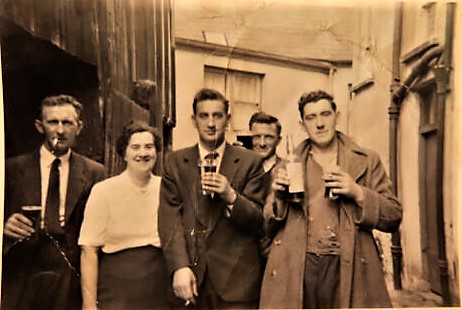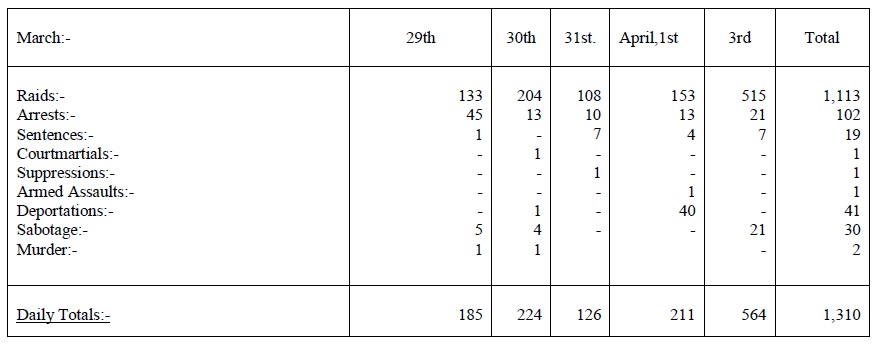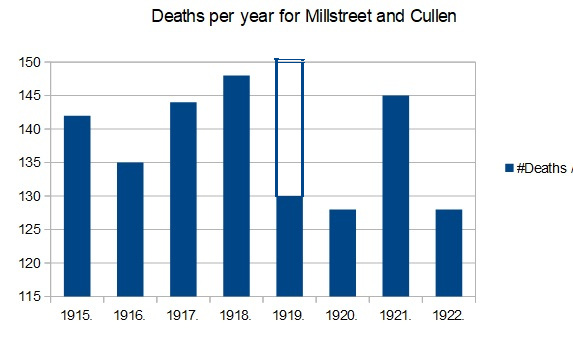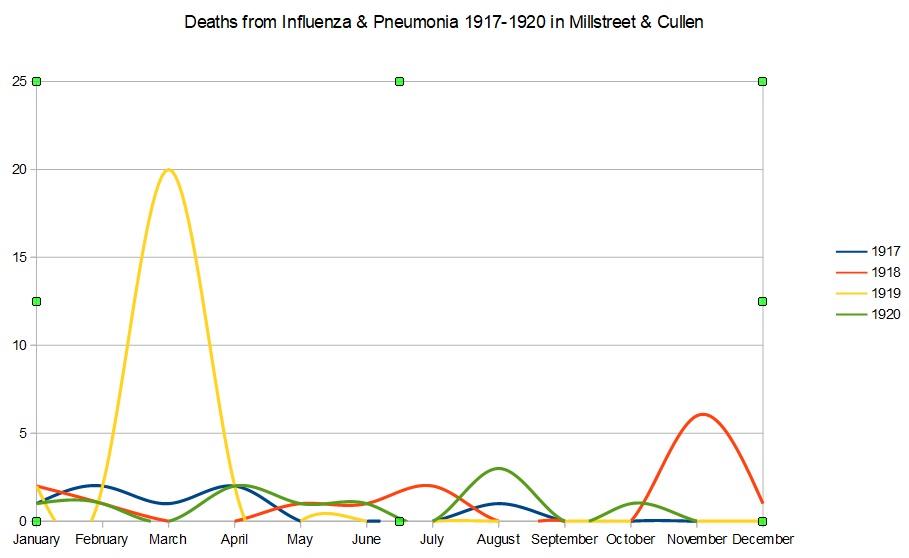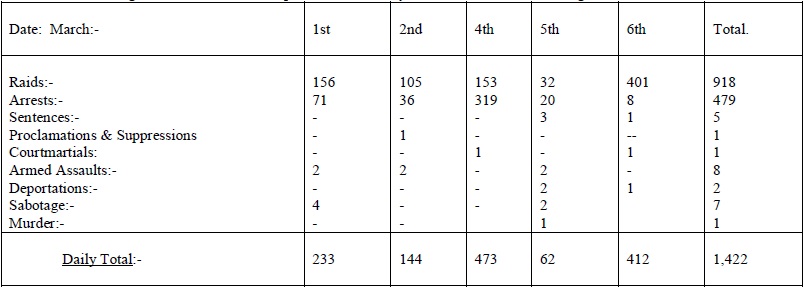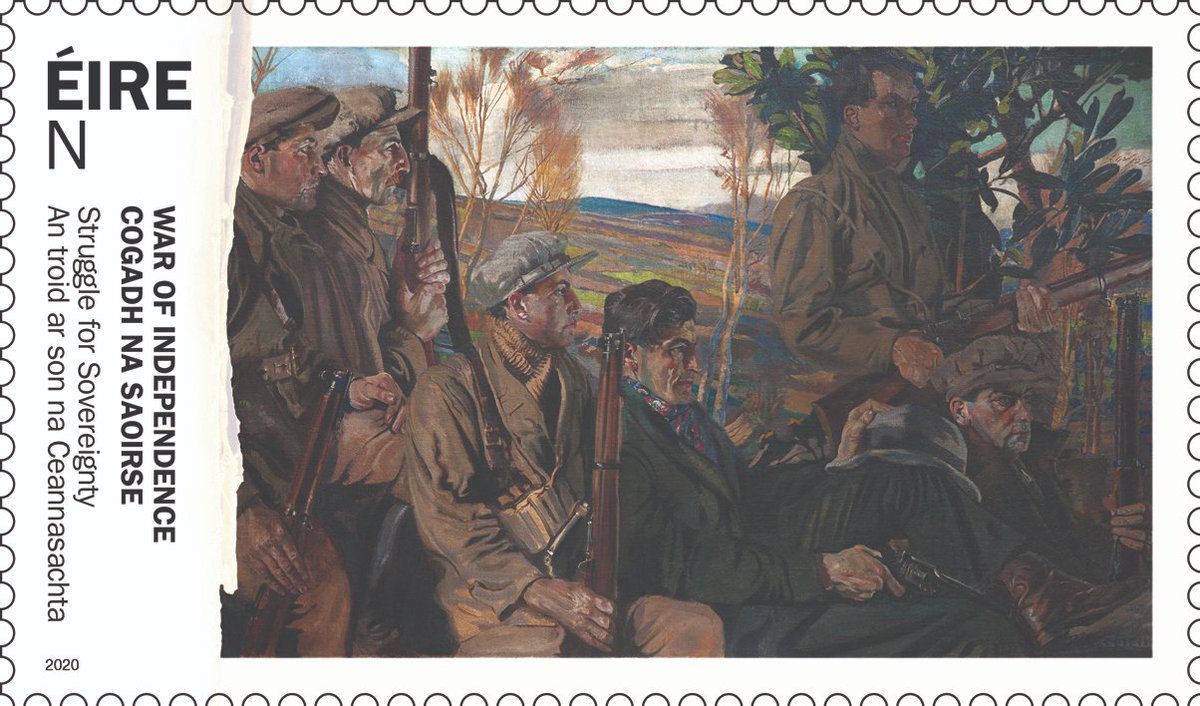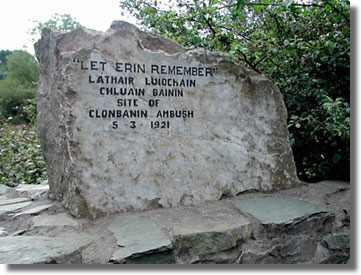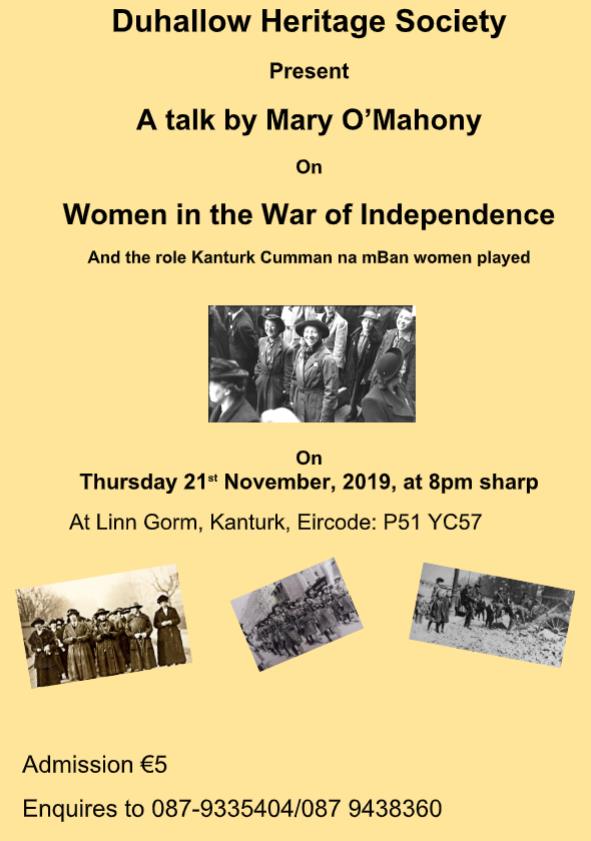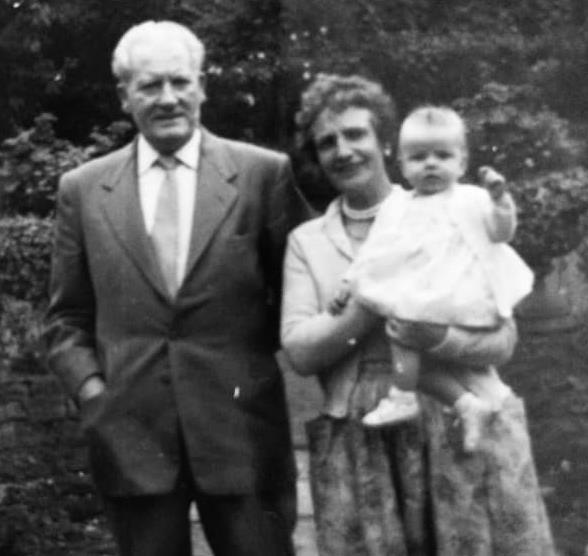Constable Benjamin Jenkinson (#53887) spent a little time in the Millstreet around 1911. He was noted at the Coolykerane Protection Post, near the Railway Station in Millstreet in the Nominal Returns for January 1911, and also is there also for the 1911 Census. A native of Antrim and Galway, he was unusual for the time, he was Protestant, and married to a Catholic lady Sarah Williams from Kanturk where he had been stationed initially. As well as Kanturk, he had spells as a policeman in Rosscarbery and Macroom. The family settled in the Coolcower area, east of Macroom where they brought up their eight children. Benjamin died in 1946 at his daughters residence on the Commons Road.
====
Service History [1]
53887 Benjamin Jenkinson
Joined: 20yrs
Height: 5’10” 1/2
Native of: Galway W, Antrim
Religion: Protestant
Married: 6/Feb/1897
Wife’s County: Cork E.R.
Recommended by: D.I. Fleury
Trade: none
Appointed: 23 July 89
Allocations: Cork E.R 11/Feb/90, Cork W.R. 1/3/97
Punishments Un.Res 2/6/92; f10/= 4/4/95; F10/= 9/1/04
Reason for Leaving: Pensioned 13/3/1915
Gratuity to Family if deceased W/P. RIC 1/307/1 (TODO: what does this mean?)
====
Nominal Return Books
(Station list at the start of each year)
1910 Dooneen PP
1911 Macroom
====
Pensioned off in 1915
In 1915, Benjamin was pensioned off at the age of 45, after 25 years. Payment of the pension for the first number of years at least was from the post office in Macroom where they lived.
25+ years service (on retirement)
53887 Cork W.R Jenkinson Benjamin Constable 45 yrs, 25yrs 7mo in force, pay:£80:12; average £70.15.1; Award of board £42.9.0; date as 13.3.1915 (on retirement)
53887 Jenkinson, Benjamin, Cork W.R., Pensioned [July 1915 Constabulary list]
Pension Leger 1919-1923 – paid at Macroom
Pension Leger 1915-1919 – paid at Macroom
TODO: when did they move to Cork?
====
Petty Session cases he brought that made the papers:
1890 Kanturk – Drunk and Disorderly
1904 Roscarbery – After hours drinking
1908 Roscarbery – suicide
1910 Macroom – Drunk and Disorderly
1911 Macroom – theft of a horse
He does not appear in the petty session books after 1890 as they seem to have been destroyed.
====
Family Details of Benjamin Jenkinson
Birth of Benjamin Jenkinson at Tohermore, Tuam on October 20th 1868; to Anne Jenkinson (Flemming) and Henry Jemkinson a Steward.
Birth of Sarah Williams of Newmarket on January 16th 1874, to Hannah Williams (Brown) and George Williams a shopkeeper, Johanna Healy Newmarket present at birth. The oldest child of ten [parent’s marriage]
Marriage of Benjamin Jenkinson and Sarah Williams at Newmarket Church on February 6th 1897 by Richard Ahern (RCC); He an RIC constable from Newmarket, son of Henry Jenkinson a farmer; She a bar maid of Kilbrin, daughter of George Williams a baker; in the presence of Stephen Crowley and Katie Kearny
Q: Jenkinson was a Protestant … how were they married in a Catholic Church?
Wife: Sarah Williams (1874–1963)
Children:
Birth of HENRY JENKINSON in 1897, Shinnagh (Rathmore, Co. Kerry) d.1987 Cork
Birth of GEORGE JENKINSON on 15 March 1900, Macroom. d.1982 Cork
Birth of ANNIE JENKINSON on 10 May 1901, Macroom. d.1913 Macroom
Birth of JAMES JENKINSON on 21 February 1903, Macroom. d.1970 NY
Birth of WILLIAM JENKINSON on 18 July 1905, Clonakilty. Died 1908 in Clonakilty
Birth of EDWARD JENKINSON on 16 March 1908, Clonakilty. d.1988 Newmarket
Birth of BENJAMIN JENKINSON on 24 May 1909, Clonakilty. d.1992 Glanmire
Birth of HANNA JENKINSON on 11 January 1913, Macroom. d.2002 Cork
Birth of RICHARD JENKINSON on 21 February 1915, Macroom. d.2005 Cork
1901 census: Residents of a house 9 in Carrigadrohid (Aghinagh, Cork)
| Surname |
Forename |
Age |
Sex
Born |
Relation to head |
Religion |
| Jenkinson |
Benjamin |
31 |
Male
Co. Galway |
Head of Family |
Episcopalian Irish Church |
| Jenkinson |
Sarah |
26 |
Female
Co. Cork |
Wife |
Roman Catholic |
| Jenkinson |
Henry John |
3 |
Male
Co. Kerry |
Son |
Roman Catholic |
| Jenkinson |
George |
1 |
Male
Co. Cork |
Son |
Episcopalian Irish Church |
| Williams |
George |
10 |
Male
Co. Cork |
Brother in Law |
Roman Catholic |
1911 census: Residents of a house 1000 in Coolykeerane (Coomlogane, Cork)
The ‘I’ initial is an incorrect transcription on the census website. It should read ‘J’, which correlates with the Nominal Return Books
| Surname |
Fore
name |
Age |
Sex |
Birth
Occupation |
Religion |
C
(Martin Cahill?) |
M |
55 |
Male |
Co. Clare
farmer’s son |
R Catholic
married |
I J
(Benjamin Jenkinson) |
B |
42 |
Male |
Co. Galway
Clerk |
C of Ireland
married |
1911 census: Residents of a house 99 in Gurteenroe Street (Macroom, Cork)
| Surname |
Forename |
Age |
Sex |
Relation to head |
Religion |
| Jenkinson |
Sarah |
36 |
Female |
Head of Family |
Roman Catholic |
| Jenkinson |
George Patrick |
12 |
Male |
Son |
Roman Catholic |
| Jenkinson |
Annie |
10 |
Female |
Daughter |
Roman Catholic |
| Jenkinson |
James Francis |
8 |
Male |
Son |
Roman Catholic |
| Jenkinson |
Edward |
3 |
Male |
Son |
Roman Catholic |
| Jenkinson |
Benjamin |
2 |
Male |
Son |
Roman Catholic |
1911 census: Son Henry John is with his grandparents in Newmarket
Marriage of Johanna Jenkinson and John Loftus on 21 September 1937 in Macroom. She gave an address of Coolcower.
Marriage of BENJAMIN JENKINSON and Mary SHEEHY on 31 October 1944. His address is Coolcower. [3]
Benjamin died at 13 Springview Terrace, Commons Road, Cork on March 27th 1946, aged 78. His wife Sarah was present at death. [GMaps: 13 Springview Terrace]
(Maybe he moved to his daughter’s house on the Commons Road to be cared for late in life)
Death of Sarah Jenkinson of 14 Springview Terrace Commons Road on May 10th 1963, aged 90, OAP, cerebral haemorrage, Joan Loftus Daughter 14 Springview terrace.
Marriage of Richard (Dick) Jenkinson and Eileen Kenneally of Newmarket [4] [5] [a]. Eileen’s mother was Johanna O’Callaghan of Liscahane, Millstreet, born to Margaret (Buckley) and Cornelius Joseph O’Callaghan (a farmer) on November 26th 1897. [1911][5] She married Timothy O’Callaghan of Newmarket in 1924.
[ancestry: jbjenkinson2]
[fb:dj]








